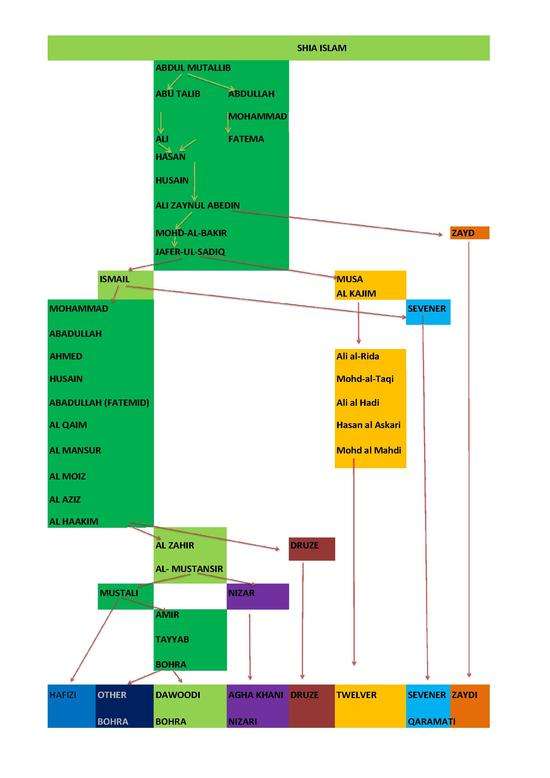Ahmad al-Wafi (Abadullah)
| Ahmad al-Wafi | |
|---|---|
 | |
| Other names | Abadullah ibn Muhammad |
| Personal | |
| Born |
Abadullah 179 AH (approximately 795/796) Medina |
| Died |
212 AH (approximately 827/828) |
| Resting place | al-Salamiyah, Syria |
| Children | Muhammad at-Taqi (Ahmed ibn Abadullah) |
| Parents |
|
| Senior posting | |
| Title | al-Azbab al-Itlaq (Absolute lord), al-Wafi |
| Religious career | |
| Initiation | 212 AH |
| Post | Eighth Isma'ili Imam |
Aḥmad al-Wafī (proper name: ʿAbdullāh ibn Muḥammad ibn Ismāʿīl, Arabic: عبد اللّه بن محمد بن إسماعيل; born 766-828 CE/149-212 AH in al-Salamiyah, Syria; Imamate 809-828 CE/193-212 AH) is the eighth Isma'ili Imam. He was the son and successor of the seventh Imam, Muhammad ibn Isma'il. [1] He was called al-Wafi "true to his word".
As the Imam, he was the supreme spiritual leader of the Ismaili community from his appointment until his death. The Nizari and Mustaali trace their Imamate lines from him and his descendants who founded the Fatimid Caliphate. For protection against his real Imam position, he was known as "Attar" (due to his profession in drug and medicine). He was succeeded by his son, Muhammad at-Taqi (Ahmed ibn Abadullah).[2] With the death of Ja'far al-Sadiq in 765 (148 AH), Isma'il in 775 (158 AH) and Muhammad in 813 (197 AH), the Isma'ili Imams were impelled to hide; this first occultation lasted from 813-882 (197-268 AH).[3]
The eighth to tenth Ismaili Imams were hidden from the public because of threats from the Abbasid Caliphate and were known by their nicknames. However, the Dawoodi Bohra in their religious text, Taqqarub, claim to have the true names of all 21 imams in sequence including the "hidden" imams: the eighth Imam, Ahmad al-Wafi; the ninth Imam, Muhammad at-Taqi, and the tenth Imam, Radi Abdullah.[4]
Residence at Salamia, Syria
As per Ismaili.net [5] residence history of Salamia is as follows:
"The Ismaili dais in search of a new residence for their Imam came to Salamia and inspected the town and approached the owner, Muhammad bin Abdullah bin Saleh, who had transformed the town into a flourishing commercial centre. They told him that there was a Hashimite merchant from Basra who was desirous of settling in the town. He readily accepted and pointed out to them a site along the main street in the market, where existed a house belonging to a certain Abu Farha. The Ismaili dais bought it for their Imam and informed him about it. Wafi Ahmad arrived to his new residence as an ordinary merchant. He soon pulled down the old building and had new ones built in its place; and also built a new wall around it. He also built a tunnel inside his house, leading to the desert, whose length was about 12 miles. Money and treasures were carried on camels to the door of that tunnel at night. The door opened and the camels entered with their loads inside the house."
Photo placed here shows the mousoleum of the Imam. Near his kabra mubarak ("blessed grave"), the tunnel opening still exists.
External links
- List of Syednas (according to Dawoodi Bohras)
- The Ismaili, their history and doctrine by Farhad Daftary
- Religion,learning and science by Young Lathan
- Medieval Islamic civilisation by Joseph w. Meri, Bacharach
- Sayyida Hurra: The Isma‘ili Sulayhid Queen of Yemenby Dr Farhad Daftary
- The Uyun al-akhbar is the most complete text written by an Ismaili/Tayyibi/Dawoodi 19th Dai Sayyedna Idris bin Hasan on the history of the Ismaili community from its origins up to the 12th century CE. period of the Fatimid caliphs al-Mustansir (d. 487/1094), the time of Musta‘lian rulers including al-Musta‘li (d. 495/1101) and al-Amir (d. 524/1130), and then the Tayyibi Ismaili community in Yemen.
Tree of the Isma'ili Imams

References
- ↑ Tabari, 3rd vol., p. 2218
- ↑ WAFI AHMAD (197-212/813-828)
- ↑ Achilles des Souza, "Mediation in Islam - an Investigation" (Rome, 1975, p. 35)
- ↑ Makarem, Sami. "The Hidden Imams of the Ismailis". Quarterly Journal of the American University of Beirut. 21.
- ↑ http://www.ismaili.net/histoire/history04/history419.html Wafi Ahmad in Salamia
